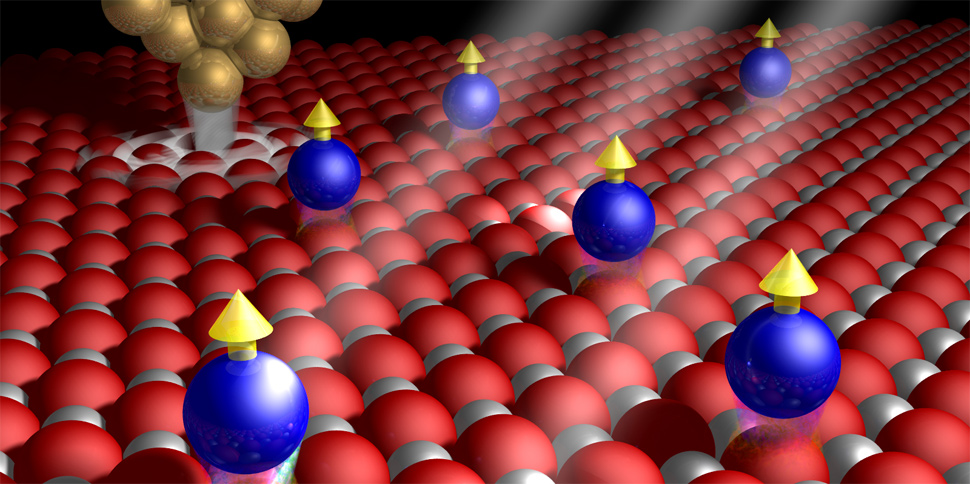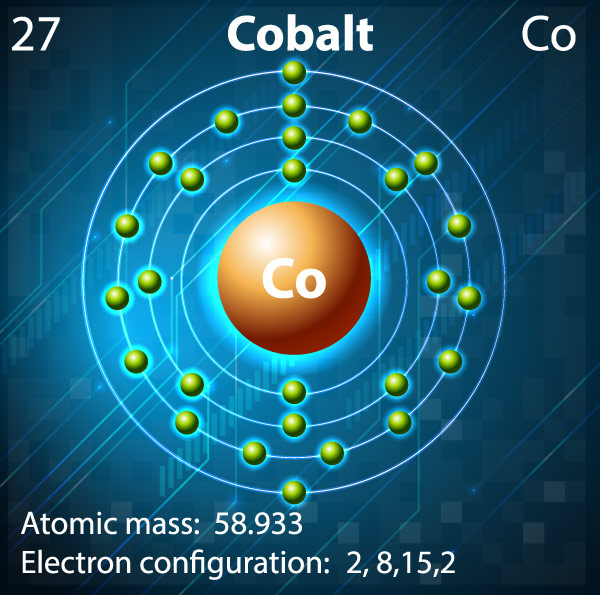
10th May 2014 Nanotechnology breakthrough: single-atom magnet Researchers have demonstrated, for the first time, the maximum theoretical limit of energy needed to control the magnetisation of a single atom. This fundamental work has major implications for magnetic research and future nanotechnology.
Magnetic devices like hard drives, magnetic random access memories (MRAMs), molecular magnets and quantum computers depend on the manipulation of magnetic properties. In an atom, magnetism arises from the spin and orbital momentum of its electrons. "Magnetic anisotropy" describes how an atom’s magnetic properties depend on the orientation of the electrons' orbits, relative to the structure of a material. It also provides directionality and stability to magnetisation. Publishing in Science, researchers led by Ecole Polytechnique Fédérale de Lausanne (EPFL) combine various experimental and computational methods to measure, for the first time, the energy needed to change the magnetic anisotropy of a single Cobalt atom. Their methodology and findings could impact a range of fields – from studies of single atom and single molecule magnetism, to quantum computing and the design of spintronic device architectures. In theory, every atom or molecule has the potential to be magnetic, since this depends on the movement of its electrons. Electrons move in two ways: spin, which can be loosely thought of as spinning around themselves; and orbit, which refers to an electron’s movement around the nucleus of its atom. Spin and orbital motion give rise to magnetisation, similar to an electric current circulating in a coil and producing a magnetic field. The spinning direction of the electrons therefore defines the direction of the magnetisation in a material. The magnetic properties of a material have a certain "preference" or "stubbornness" towards a specific direction. This phenomenon is referred to as "magnetic anisotropy," and is described as the "directional dependence" of a material’s magnetism. Changing its "preference" requires a certain amount of energy. The total energy of a material’s magnetic anisotropy is a fundamental obstacle when it comes to downscaling of technology like MRAMs, computer hard drives and even quantum computers, which use different electron spin states as distinct information units, or "qubits". The team at EPFL – in collaboration with scientists from ETH Zurich, the Paul Scherrer Institute and IBM Almaden Research Center – developed a method to determine the maximum possible magnetic anisotropy for a single Cobalt atom. This metal is widely used in permanent magnets, as well as in magnetic recording materials for data storage applications.
The researchers used a technique called "inelastic electron tunnelling spectroscopy" to probe the quantum spin states of a single cobalt atom bound to a layer of magnesium oxide (MgO), as shown in the illustration at the top of this page. This technique uses an atom-sized scanning tip, which allows the passage (or "tunnelling") of electrons to the cobalt atom. When electrons were tunnelled through by researchers, this transferred energy and induced changes in the spin properties. The experiments revealed the maximum magnetic anisotropy energy of a single atom (~58 millielectron volts) and the longest spin lifetime for a single transition metal atom. When placed on the ultra-thin layer of magnesium oxide, these individual cobalt atoms were found to have triple the magnetism, atom for atom, than a layer made of pure cobalt. In addition, these single-atom magnets were very stable against external perturbations, which is a prerequisite for technological applications. These fundamental findings open the way for a better understanding of magnetic anisotropy and present a single-atom model system that could be used as a future "qubit". "Quantum computing uses quantum states of matter – and magnetic properties are such a quantum state," says Harald Brune, from EPFL. "They have a life-time, and you can use the individual surface-adsorbed atoms to make qubits. Our system is a model for such a state. It allows us to optimise the quantum properties, and it is easier than previous ones, because we know exactly where the cobalt atom is in relation to the MgO layer." "Miniaturisation is limited physically by the atomic structure of the material," said Professor Pietro Gambardella, ETH Zurich. "In our work, we have now shown that it is possible to create stable magnetic components out of single atoms; i.e. the smallest possible structure."
Comments »
|








